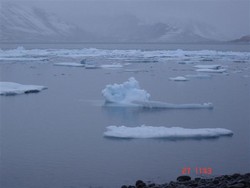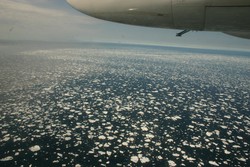Sea ice around Iceland
Ice in the ocean around Iceland has mostly arrived from afar. It comes from the Denmark strait, which connects the Atlantic Ocean and the Arctic Ocean, between Iceland and Greenland. Sometimes the ice comes directly from north to the northeast corner of Iceland, but all the ice comes from the same source: The East-Greenland current which flows from the Arctic Ocean due south along the east coast of Greenland, passing northwest Iceland. This great cold current transports a lot of ice southwards, both sea ice which is formed in sea water and ice bergs which break off from the glacier of Greenland.
Late winter the ice can cover fishing grounds northwest of Iceland. This ice is often carried eastwards, into the pathways of ships along the Icelandic coast and sometimes into fjords and bays. Ice bergs are also seen around Iceland, especially in autumn.
Whether ice comes close to Iceland depends on three factors: The quantity of ice in Denmark strait, the condition in the ocean near Iceland, i.e. temperature, salinity and layering, and the overall air circulation in the northern hemisphere, i.e. lows and highs, especially the development of static high pressure over either Greenland or the Atlantic Ocean.

A combination of certain circumstances causes the long dreaded "hafis" which meant very cold winters and harsh living in earlier centuries. Sometimes loss of lifestock and local starvation followed, though rarely.
Contrarily, ice on the Icelandic fishing grounds is quite common, especially in the northwest. Therefore, sea ice is monitored by regular flights for this purpose. Based on observations from the Icelandic Coast Guard and other vessels that sight sea ice, warnings are issued by IMO when considered necessary. The Danish Meteorological Institute produces weekly maps showing the extent of ice dispersion.
(reference: Hafís við Ísland by Þór Jakobsson)




